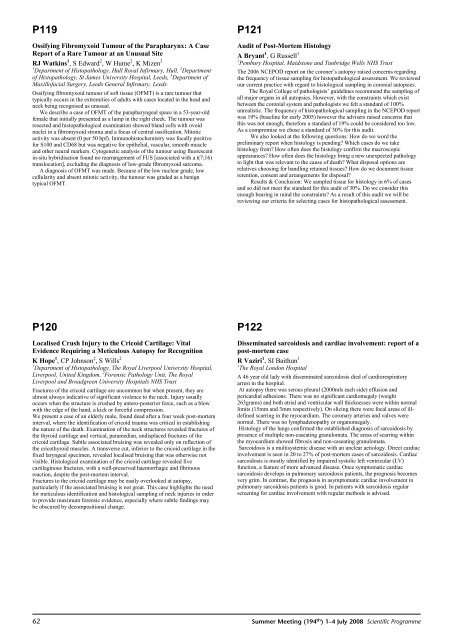2008 Summer Meeting - Leeds - The Pathological Society of Great ...
2008 Summer Meeting - Leeds - The Pathological Society of Great ...
2008 Summer Meeting - Leeds - The Pathological Society of Great ...
Create successful ePaper yourself
Turn your PDF publications into a flip-book with our unique Google optimized e-Paper software.
P119Ossifying Fibromyxoid Tumour <strong>of</strong> the Parapharynx: A CaseReport <strong>of</strong> a Rare Tumour at an Unusual SiteRJ Watkins 1 ,SEdward 2 ,WHume 2 , K Mizen 31 Department <strong>of</strong> Histopathology, Hull Royal Infirmary, Hull, 2 Department<strong>of</strong> Histopathology, St James University Hospital, <strong>Leeds</strong>, 3 Department <strong>of</strong>Maxill<strong>of</strong>acial Surgery, <strong>Leeds</strong> General Infirmary, <strong>Leeds</strong>Ossifying fibromyxoid tumour <strong>of</strong> s<strong>of</strong>t tissue (OFMT) is a rare tumour thattypically occurs in the extremities <strong>of</strong> adults with cases located in the head andneck being recognised as unusual.We describe a case <strong>of</strong> OFMT <strong>of</strong> the parapharyngeal space in a 53-year-oldfemale that initially presented as a lump in the right cheek. <strong>The</strong> tumour wasresected and histopathological examination showed bland cells with ovoidnuclei in a fibromyxoid stroma and a focus <strong>of</strong> central ossification. Mitoticactivity was absent (0 per 50 hpf). Immunohistochemistry was focally positivefor S100 and CD68 but was negative for epithelial, vascular, smooth muscleand other neural markers. Cytogenetic analysis <strong>of</strong> the tumour using fluorescentin-situ hybridisation found no rearrangement <strong>of</strong> FUS [associated with a t(7;16)translocation], excluding the diagnosis <strong>of</strong> low-grade fibromyxoid sarcoma.A diagnosis <strong>of</strong> OFMT was made. Because <strong>of</strong> the low nuclear grade, lowcellularity and absent mitotic activity, the tumour was graded as a benigntypical OFMT.P121Audit <strong>of</strong> Post-Mortem HistologyABryant 1 , G Russell 11 Pembury Hospital, Maidstone and Tunbridge Wells NHS Trust<strong>The</strong> 2006 NCEPOD report on the coroner’s autopsy raised concerns regardingthe frequency <strong>of</strong> tissue sampling for histopathological assessment. We reviewedour current practice with regard to histological sampling in coronial autopsies.<strong>The</strong> Royal College <strong>of</strong> pathologists’ guidelines recommend the sampling <strong>of</strong>all major organs in all autopsies. However, with the constraints which existbetween the coronial system and pathologists we felt a standard <strong>of</strong> 100%unrealistic. <strong>The</strong> frequency <strong>of</strong> histopathological sampling in the NCEPOD reportwas 19% (baseline for early 2005) however the advisers raised concerns thatthis was not enough, therefore a standard <strong>of</strong> 19% could be considered too low.As a compromise we chose a standard <strong>of</strong> 30% for this audit.We also looked at the following questions: How do we word thepreliminary report when histology is pending? Which cases do we takehistology from? How <strong>of</strong>ten does the histology confirm the macroscopicappearances? How <strong>of</strong>ten does the histology bring a new unexpected pathologyto light that was relevant to the cause <strong>of</strong> death? What disposal options arerelatives choosing for handling retained tissues? How do we document tissueretention, consent and arrangements for disposal?Results & Conclusion: We sampled tissue for histology in 6% <strong>of</strong> casesand so did not meet the standard for this audit <strong>of</strong> 30%. Do we consider thisenough bearing in mind the constraints? As a result <strong>of</strong> this audit we will bereviewing our criteria for selecting cases for histopathological assessment.P120Localised Crush Injury to the Cricoid Cartilage: VitalEvidence Requiring a Meticulous Autopsy for RecognitionKHope 1 , CP Johnson 2 , S Wills 21 Department <strong>of</strong> Histopathology, <strong>The</strong> Royal Liverpool University Hospital,Liverpool, United Kingdom, 2 Forensic Pathology Unit, <strong>The</strong> RoyalLiverpool and Broadgreen University Hospitals NHS TrustFractures <strong>of</strong> the cricoid cartilage are uncommon but when present, they arealmost always indicative <strong>of</strong> significant violence to the neck. Injury usuallyoccurs when the structure is crushed by antero-posterior force, such as a blowwith the edge <strong>of</strong> the hand, a kick or forceful compression.We present a case <strong>of</strong> an elderly male, found dead after a four week post-morteminterval, where the identification <strong>of</strong> cricoid trauma was critical in establishingthe nature <strong>of</strong> the death. Examination <strong>of</strong> the neck structures revealed fractures <strong>of</strong>the thyroid cartilage and vertical, paramedian, undisplaced fractures <strong>of</strong> thecricoid cartilage. Subtle associated bruising was revealed only on reflection <strong>of</strong>the cricothyroid muscles. A transverse cut, inferior to the cricoid cartilage in thefixed laryngeal specimen, revealed localised bruising that was otherwise notvisible. Histological examination <strong>of</strong> the cricoid cartilage revealed fivecartilaginous fractures, with a well-preserved haemorrhagic and fibrinousreaction, despite the post-mortem interval.Fractures to the cricoid cartilage may be easily overlooked at autopsy,particularly if the associated bruising is not great. This case highlights the needfor meticulous identification and histological sampling <strong>of</strong> neck injuries in orderto provide maximum forensic evidence, especially where subtle findings maybe obscured by decompositional change.P122Disseminated sarcoidosis and cardiac involvement: report <strong>of</strong> apost-mortem caseR Vaziri 1 , SI Baithun 11 <strong>The</strong> Royal London HospitalA 46 year old lady with disseminated sarcoidosis died <strong>of</strong> cardiorespiratoryarrest in the hospital.At autopsy there was serous pleural (2000mls each side) effusion andpericardial adhesions. <strong>The</strong>re was no significant cardiomegaly (weight263grams) and both atrial and ventricular wall thicknesses were within normallimits (15mm and 3mm respectively). On slicing there were focal areas <strong>of</strong> illdefinedscarring in the myocardium. <strong>The</strong> coronary arteries and valves werenormal. <strong>The</strong>re was no lymphadenopathy or organomegaly.Histology <strong>of</strong> the lungs confirmed the established diagnosis <strong>of</strong> sarcoidosis bypresence <strong>of</strong> multiple non-caseating granulomata. <strong>The</strong> areas <strong>of</strong> scarring withinthe myocardium showed fibrosis and non-caseating granulomata.Sarcoidosis is a multisystemic disease with an unclear aetiology. Direct cardiacinvolvement is seen in 20 to 27% <strong>of</strong> post-mortem cases <strong>of</strong> sarcoidosis. Cardiacsarcoidosis is mostly identified by impaired systolic left ventricular (LV)function, a feature <strong>of</strong> more advanced disease. Once symptomatic cardiacsarcoidosis develops in pulmonary sarcoidosis patients, the prognosis becomesvery grim. In contrast, the prognosis in asymptomatic cardiac involvement inpulmonary sarcoidosis patients is good. In patients with sarcoidosis regularscreening for cardiac involvement with regular methods is advised.62 <strong>Summer</strong> <strong>Meeting</strong> (194 th ) 1–4 July <strong>2008</strong> Scientific Programme













